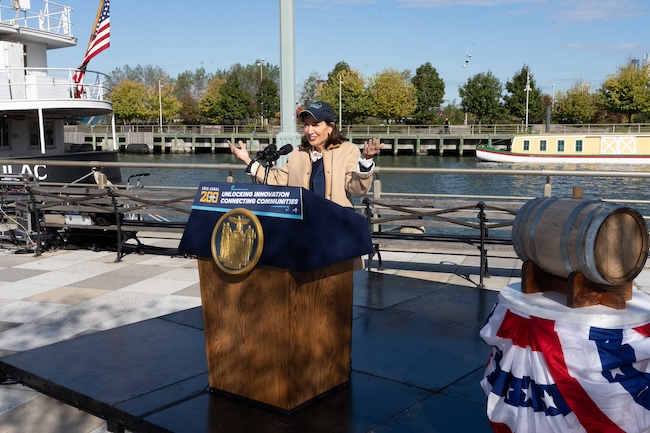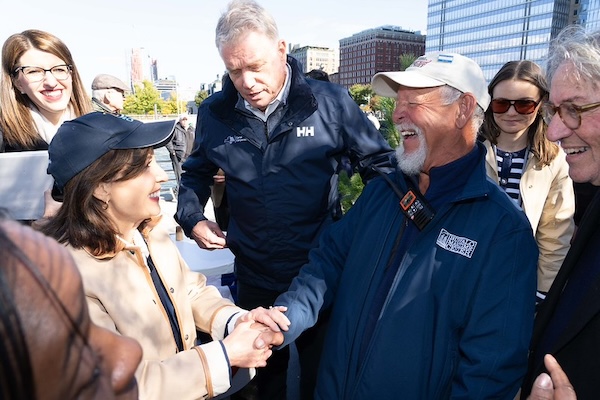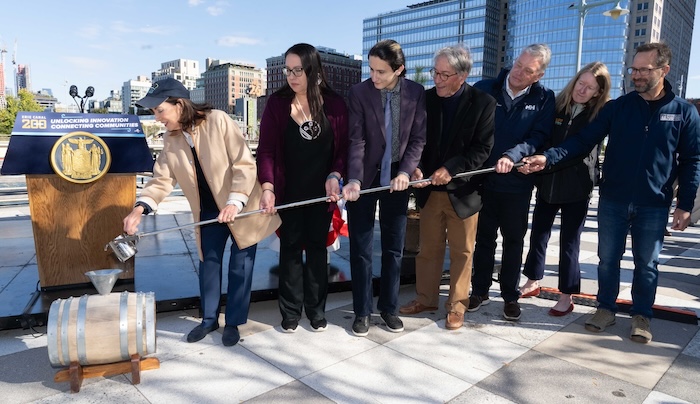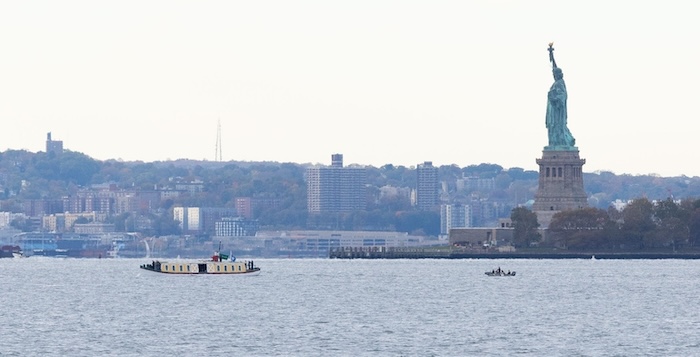Governor joins in celebration of Erie Canal on 200th anniversary
Replica of Seneca Chief completes bicentennial voyage on canal, reaching NYC

Photos by Don Pollard/ Office of Governor Kathy Hochul – Governor Hochul today marked the 200th anniversary of the opening of the original Erie Canal in New York City with the arrival of the Buffalo Maritime Center’s Erie Canal Boat Seneca Chief. Hochul is speaking at Pier 26 at Hudson River Park in New York City
Press Release, Gov. Kathy Hochul’s Office
New York City – Governor Kathy Hochul today marked the 200th anniversary of the opening of the original Erie Canal in New York City with the arrival of the Buffalo Maritime Center’s Erie Canal Boat Seneca Chief.
The boat is a replica of the original vessel Governor DeWitt Clinton traveled on from Buffalo to New York City in 1825. The current voyage began Sept. 24 in Buffalo. The Seneca Chief made 28 stops along the Erie Canal and Hudson River before ending its journey at Pier 26 at Hudson River Park in New York City.
Buffalo Maritime Center Founder John Montague said, “From the outset of this project, our aim was to commemorate the Erie Canal and raise awareness of its profound impact on American history. By building and voyaging across New York State with our authentic replica canal boat, we have succeeded beyond our dreams. At the same time, we’ve succeeded in reconnecting communities and individuals around our shared canal history and heritage. We have been amazed to discover on our voyage the public’s interest and commitment in shaping the canal’s future.”

Gov. Hochul congratulates Roger Allen, Master Boatbuilder of the Seneca Chief replica, for the successful 33-day trip, retracing the route of the original Seneca Chief that brought Gov. DeWitt Clinton on the freshly built Erie Canal. Brian Stratton, the state’s canal commissioner, is in back.
Today’s Erie Canal is now part of the 524-mile New York State Canal system managed by the New York Power Authority (NYPA) and New York State Canal Corporation. As the Erie Canal enters its third century of operation, it has primarily become a recreational and cultural destination, with a focus on arts and culture, sustainability, and accessibility, while still moving cargo too large for other means of transportation.
“For two centuries, the Erie Canal has been a symbol of ingenuity and perseverance, shaping the economic and social landscape of New York and the United States,” Governor Hochul said. “As a Buffalo native, I have logged hundreds of hours on the canals and know first-hand of the impact and beauty. As we celebrate this incredible bicentennial milestone, we look forward to the Canal’s third century of operation and are committed to ensuring a resilient and accessible Canal system for all New Yorkers for centuries to come.”
The Governor was introduced at today’s event by DeWitt Clinton’s 15-year-old great-great-great-great-great-grandson, DeWitt Silber.
The Erie Canal has been a cornerstone in the development of New York State as we know it, and the nation. It has served as a vital connector for commerce, linking the Atlantic Ocean to the Great Lakes, and facilitating the movement of goods and people. Over the years, the Canal has played significant roles in major historical movements, including the Underground Railroad, Women’s Right to Vote, the expansion of religions, fostering communities and driving progress.
Through their More Voices initiative, NYPA and the Canal Corporation are working to share a more comprehensive narrative of the Erie Canal’s history. Topics include the stories of underrepresented communities including those of African Americans, women, immigrants, and the Haudenosaunee Confederacy.

Gov. Hochul pours water into a barrel in a ceremony that was done at each stop the Seneca Chief made along the canal as part of a 33-day trip to New York City. The “Gathering of the Waters” differed from the original “Wedding of the Waters” when Gov. DeWitt Clinton poured water from Lake Erie into New York Harbor in 1825, following the maiden journey along the completed canal.
To acknowledge the displacement of indigenous people during the building of the Canal, an Eastern White Pine Tree was planted at each stop of the current Seneca Chief voyage that represents the strength of the Haudenosaunee people, as well as a promise for a sustainable future for the Erie Canal. In Haudenosaunee culture, the White Pine also holds significance as the Tree of Peace.
New York State Canal Corporation Director and Erie Canal Bicentennial Commission Co-Chair Brian U. Stratton said, “The Erie Canal has been a testament to human ingenuity and the power of connectivity. As we look ahead, we are dedicated to enhancing its accessibility and resilience, ensuring it remains a vital resource for generations to come.”
Since taking office, Governor Hochul has emphasized the state’s continuing commitment to the long-term viability of the canal system, designating $50 million in each of the past two state budgets to rehabilitate reservoir dams, improve earthen embankment dams, and repair aging water control structures, many of which predate Clinton’s inaugural Erie Canal voyage. The funds are in addition to NYPA’s annual investment for canal system maintenance and operations.

Photo courtesy of NYS Canal Corp. – The replica of Seneca Chief passes by the Statue of Liberty on Liberty Island.
As the Erie Canal’s third century of operation begins, the New York State Canal Corporation is gearing up to carry out the recently published Canal Recreationway 2050 Plan. Created with input from hundreds of stakeholders throughout the canal corridor, it is structured around seven guiding principles that together form a comprehensive vision for the 524-mile Canal system of waterways, trails and parks. The guiding principles include cultural heritage, accessibility, economic impact, ecological benefit, and environmental resiliency.
Most recently, the Canal Corporation began identifying property along the Erie Canal where pollinator meadows can be created. This endeavor not only aims to reduce maintenance needs, but also aims to enhance biodiversity, support vital ecosystems, and ensure the Canal’s ecological health for the next century. This sustainable approach honors the Canal system’s rich history while fostering environmental stewardship and resilience, contributing to a greener, more vibrant future for generations to come. 16 acres have been identified to date, with hundreds more to come.
The New York State Canal system endeavors to become a worldwide destination for accessible recreation through On the Canals, as well as NYPA and Canal Corporation’s On the Canals Accessibility Education Program. Now in its sixth year, On the Canals provides free programming across the Canal system through local providers to get people recreating on the water and the Canalway Trails.
With its relatively calm waters and level trail surfaces, it is an ideal location for people of all abilities to recreate. The On the Canals Accessibility Education Program, now in its second year, works with participating businesses to ensure they are receiving the correct tools and knowledge they need to guarantee that their facilities and programming are fully accessible for all who seek to enjoy recreation along the Canal system.





































































